Soil Tillage and Cropping System Effects on the Physical-Hydric Properties of a Soil under No-Tillage
Abstract
1. Introduction
2. Materials and Methods
2.1. Site and Tillage Systems Description
2.2. Experimental Design and Treatments
2.3. Soil Sampling and Physical–Hydric Properties
2.4. Visual Evaluation of Soil Structure
2.5. Evaluation of the Plant Root System
2.6. Data Analysis
3. Results
3.1. Soil Physical–Hydric Properties
3.2. Field Measurement of the Soil Structure Using the VESS
3.3. Root Dry Biomass of Soybean, Maize, and Palisade Grass
4. Discussion
5. Conclusions
Author Contributions
Funding
Institutional Review Board Statement
Informed Consent Statement
Data Availability Statement
Acknowledgments
Conflicts of Interest
References
- Awe, G.O.; Reichert, J.M.; Fontanela, E. Sugarcane production in the subtropics: Seasonal changes in soil properties and crop yield in no-tillage, inverting and minimum tillage. Soil Tillage Res. 2020, 196, e104447. [Google Scholar] [CrossRef]
- Blanco-Canqui, H.; Mikha, M.M.; Presley, D.R.; Claassen, M.M. Addition of cover crops enhances no-till potential for improving soil physical properties. Soil Sci. Soc. Am. J. 2011, 75, 1471–1482. [Google Scholar] [CrossRef]
- Blanco-Canqui, H.; Ruis, S.J. No-tillage and soil physical environment. Geoderma 2018, 326, 164–200. [Google Scholar] [CrossRef]
- Carneiro, C.E.A.; Melém Júnior, N.J.; de Azevedo, M.C.B.; Andrade, E.A.; Koguishi, M.S.; Diehl, R.C.; Ricce, W.S.; Passarin, A.L.; Vaz, R.H.M.; Stelmachuk, T.L.L.; et al. Efeitos dos sistemas de manejo sobre o carbono orgânico total e carbono residual de um latossolo vermelho eutroférrico. Semin. Ciências Agrárias 2009, 30, 5–10. Available online: https://www.redalyc.org/pdf/4457/445744091001.pdf (accessed on 12 November 2023). [CrossRef][Green Version]
- Hobson, D.; Harty, M.; Tracy, S.R.; McDonnell, K. The effect of tillage depth and traffic management on soil properties and root development during two growth stages of winter wheat (Triticum aestivum L.). Soil 2022, 8, 391–408. [Google Scholar] [CrossRef]
- Nunes, M.R.; Karlen, D.L.; Moorman, T.B. Tillage intensity effects on soil structure indicators—A US meta-analysis. Sustainability 2020, 12, 2071. [Google Scholar] [CrossRef]
- Pires, L.F.; Borges, J.A.R.; Rosa, J.A.; Cooper, M.; Heck, R.J.; Passoni, S.; Roque, W.L. Soil structure changes induced by tillage systems. Soil Tillage Res. 2017, 165, 66–79. [Google Scholar] [CrossRef]
- Reichert, J.M.; Suzuki, L.E.A.S.; Reinert, D.J. Compactação do solo em sistemas agropecuários e florestais: Identificação, efeitos, limites críticos e mitigação. In Tópicos em Ciência do Solo; Ceretta, C.A., Silva, L.S., Reichert, J.M., Eds.; Sociedade Brasileira de Ciência do Solo: Viçosa, Brazil, 2007; pp. 49–134. Available online: http://fisicadosolo.ccr.ufsm.quoos.com.br/downloads/Producao_Artigos/2007_Topicos.pdf (accessed on 12 November 2023).
- Kassam, A.; Friedrich, T.; Derpsch, R.; Kienzle, J. Overview of the worldwide spread of conservation agriculture. Field Actions Science Reports. J. Field Actions 2015, 8, 1–12. [Google Scholar]
- Reichert, J.M.; da Rosa, V.T.; Vogelmann, E.S.; da Rosa, D.P.; Horn, R.; Reinert, D.J.; Sattler, A.; Denardin, J.E. Conceptual framework for capacity and intensity physical soil properties affected by short and long-term (14 years) continuous no-tillage and controlled traffic. Soil Tillage Res. 2016, 158, 123–136. [Google Scholar] [CrossRef]
- Tian, M.; Qin, S.; Whalley, W.R.; Zhou, H.; Ren, T.; Gao, W. Changes of soil structure under different tillage management assessed by bulk density, penetrometer resistance, water retention curve, least limiting water range and X-ray computed tomography. Soil Tillage Res. 2022, 221, 105420. [Google Scholar] [CrossRef]
- Gao, W.; Hodgkinson, L.; Jin, K.; Watts, C.W.; Ashton, R.W.; Shen, J.; Ren, T.; Dodd, I.C.; Binley, A.; Phillips, A.L.; et al. Deep roots and soil structure. Plant Cell Environ. 2016, 39, 1662–1668. [Google Scholar] [CrossRef] [PubMed]
- Vizioli, B.; Cavalieri-Polizeli, K.M.V.; Tormena, C.A.; Barth, G. Effects of long-term tillage systems on soil physical quality and crop yield in a Brazilian Ferralsol. Soil Tillage Res. 2021, 209, 104935. [Google Scholar] [CrossRef]
- Franchini, J.C.; Debiasi, H.; Sacoman, A.; Nepomuceno, A.L.; Farias, J.R.B. Manejo do Solo Para Redução das Perdas de Produtividade Pela Seca; Documentos 314; Embrapa Soja: Londrina, Brazil, 2009; 39p. [Google Scholar]
- Pereira Neto, O.C.; Guimarães, M.F.; Ralisch, R.; Fonseca, I.C.B. Análise do tempo de consolidação do sistema de plantio direto. Rev. Bras. De Eng. Agrícola E Ambient. 2007, 11, 489–496. [Google Scholar] [CrossRef]
- Franchini, J.C.; Debiasi, H.; Balbinot, A.A., Jr.; Tonon, B.C.; Farias, J.R.B.; Oliveira, M.C.N.d.; Torres, E. Evolution of crop yields in different tillage and cropping systems over two decades in southern Brazil. Field Crops Res. 2012, 137, 178–185. [Google Scholar] [CrossRef]
- Martínez, I.; Chervet, A.; Weisskopf, P.; Sturny, W.G.; Rek, J.; Keller, T. Two decades of no-till in the Oberacker long-term field experiment: Part II. Soil porosity and gas transport parameters. Soil Tillage Res. 2016, 163, 130–140. [Google Scholar] [CrossRef]
- Hamamoto, S.; Moldrup, P.; Kawamoto, K.; Sakaki, T.; Nishimura, T.; Komatsu, T. Pore network structure linked by X-ray CT to particle characteristics and transport parameters. Soils Found. 2016, 56, 676–690. [Google Scholar] [CrossRef]
- Kuncoro, P.H.; Koga, K.; Satta, N.; Muto, Y. A study on the effect of compaction on transport properties of soil gas and water I: Relative gas diffusivity, air permeability, and saturated hydraulic conductivity. Soil Tillage Res. 2014, 143, 172–179. [Google Scholar] [CrossRef]
- Collares, G.L.; Reinert, D.J.; Reichert, J.M.; Kaiser, D.R. Compactação de um latossolo induzida pelo tráfego de máquinas e sua relação com o crescimento e produtividade de feijão e trigo. Rev. Bras. Cienc. Solo 2008, 32, 933–942. [Google Scholar] [CrossRef]
- Suzuki, L.E.A.S.; Reinert, D.J.; Alves, M.C.; Reichert, J.M. Critical limits for soybean and black bean root growth, based on macroporosity and penetrability, for soils with distinct texture and management systems. Sustainability 2022, 14, 2958. [Google Scholar] [CrossRef]
- Soil Survey Staff. Keys to Soil Taxonomy, 12th ed.; USDA—Natural Resources Conservation Service: Washington, DC, USA, 2014. Available online: https://www.nrcs.usda.gov/wps/portal/nrcs/detail/soils/survey/class/taxonomy/?cid=nrcs142p2_053580 (accessed on 8 December 2021).
- IUSS Working Group WRB. World Reference Base for Soil Resources 2014, Update 2015 International Soil Classification System for Naming Soils and Creating Legends for Soil Maps; World Soil Resources Reports No. 106; FAO: Rome, Italy, 2015. [Google Scholar]
- Santos, H.G.; Jacomine, P.K.T.; Anjos, L.H.; Oliveira, V.A.; Lumbreras, J.F.; Coelho, M.R.; Almeida, J.A.; Araujo Filho, J.C.; Oliveira, J.B.; Cunha, T.J.F. Sistema Brasileiro de Classificação de Solos; Embrapa: Brasília, Brazil, 2018; ISBN 9788570358004. Available online: https://ainfo.cnptia.embrapa.br/digital/bitstream/item/199517/1/SiBCS-2018-pdf (accessed on 5 October 2022).
- Bergamaschi, H.; Melo, R.W.; Guadagnin, M.R.; Cardoso, L.S.; Silva, M.I.G.; Comiran, F.; Dalsin, F.; Tessari, M.L.; Brauner, P.C. Boletins Agrometeorológicos da Estação Experimental Agronômica da UFRGS; Editora UFRGS: Porto Alegre, Brazil, 2013; 8p, Available online: https://www.ufrgs.br/agronomia/joomla/files/EEA/Srie_Meteorolgica_da_EEA-UFRGS.pdf (accessed on 1 September 2023).
- Reynolds, W.D.; Bowman, B.T.; Drury, C.F.; Tan, C.S.; Lu, X. Indicators of good soil physical quality: Density and storage parameters. Geoderma 2002, 110, 131–146. [Google Scholar] [CrossRef]
- Reynolds, W.D.; Elrick, D.E. Hydraulic conductivity of saturated soils, constant head method. In Methods of Soil Analyses; Part 4, Physical Methods; Book Series 5; Soil Science Society of America: Madison, WI, USA, 2002; pp. 694–700. [Google Scholar]
- Guimarães, R.M.L.; Ball, B.C.; Tormena, C.A. Improvements in the visual evaluation of soil structure. Soil Use Manag. 2011, 27, 395–403. [Google Scholar] [CrossRef]
- Ball, B.C.; Batey, T.; Munkholm, L.J. Field assessment of soil structural quality—A development of the Peerlkamp test. Soil Use Manag. 2007, 23, 329–337. [Google Scholar] [CrossRef]
- Pimentel-Gomes, F.; Garcia, C.H. Estatística Aplicada a Experimentos Agronômicos e Florestais: Exposição com Exemplos e Orientações Para Uso de Aplicativos; FEALQ: Piracicaba, Brazil, 2002; 309p. [Google Scholar]
- Grable, A.R.; Siemer, E.G. Effects of bulk density, aggregate size, and soil water suction on oxygen diffusion, redox potentials, and elongation of corn roots. Soil Sci. Soc. Am. J. 1968, 32, 180–186. [Google Scholar] [CrossRef]
- Ferreira, E.B.; Cavalcanti, P.P.; Nogueira, D.A. ExpDes: An R package for ANOVA and experimental designs. Appl. Math. 2014, 5, 2952. [Google Scholar] [CrossRef]
- Mukaka, M.M. Statistics Corner: A guide to appropriate use of correlation coefficient in medical research. Malawi Med. J. 2012, 24, 69–71. Available online: https://www.ncbi.nlm.nih.gov/pmc/articles/PMC3576830/pdf/MMJ2403-0069.pdf (accessed on 12 November 2023). [PubMed]
- Schober, P.; Boer, C.; Schwarte, L.A. Correlation coefficients: Appropriate use and interpretation. Anesth Analg. 2018, 126, 1763–1768. [Google Scholar] [CrossRef] [PubMed]
- Nunes, M.R.; Pauletto, E.A.; Denardin, J.E.; Suzuki, L.E.A.S.; van Es, H.M. Dynamic changes in compressive properties and crop response after chisel tillage in a highly weathered soil. Soil Tillage Res. 2019, 186, 183–190. [Google Scholar] [CrossRef]
- Reichert, J.M.; Brandt, A.A.; Rodrigues, M.F.; da Veiga, M.; Reinert, D.J. Is chiseling or inverting tillage required to improve mechanical and hydraulic properties of sandy clay loam soil under long-term no-tillage? Geoderma 2017, 301, 72–79. [Google Scholar] [CrossRef]
- Reichert, J.M.; Suzuki, L.E.A.S.; Reinert, D.J.; Horn, R.; Håkansson, I. Reference bulk density and critical degree-of-compactness for no-till crop production in subtropical highly weathered soils. Soil Tillage Res. 2009, 102, 242–254. [Google Scholar] [CrossRef]
- Schlüter, S.; Großmann, C.; Diel, J.; Wu, G.M.; Tischer, S.; Deubel, A.; Rücknagel, J. Long-term effects of conventional and reduced tillage on soil structure, soil ecological and soil hydraulic properties. Geoderma 2018, 332, 10–19. [Google Scholar] [CrossRef]
- Lopes, V.S.; Cardoso, I.M.; Fernandes, O.R.; Rocha, G.C.; Simas, F.N.B.; Moura, W.M.; Santana, F.C.; Veloso, G.V.; Luz, J.M.R. The establishment of a secondary forest in a degraded pasture to improve hydraulic properties of the soil. Soil Tillage Res. 2020, 198, 104538. [Google Scholar] [CrossRef]
- Silva, R.F.; Severiano, E.C.; Oliveira, G.C.; Barbosa, S.M.; Peixoto, D.S.; Tassinari, D.; Silva, B.M.; Silva, S.H.G.; Dias Júnior, M.S.; Figueiredo, T.A.F.R. Changes in soil profile hydraulic properties and porosity as affected by deep tillage soil preparation and Brachiaria grass intercropping in a recent coffee plantation on a naturally dense Inceptisol. Soil Tillage Res. 2021, 213, 105127. [Google Scholar] [CrossRef]
- Zhu, P.; Zhang, G.; Zhang, B. Soil saturated hydraulic conductivity of typical revegetated plants on steep gully slopes of Chinese Loess Plateau. Geoderma 2022, 412, 115717. [Google Scholar] [CrossRef]
- Genro Junior, S.A.; Reinert, D.J.; Reichert, J.M.; Albuquerque, J.A. Atributos físicos de um Latossolo Vermelho e produtividade de culturas cultivadas em sucessão e rotação. Ciência Rural 2009, 39, 65–73. [Google Scholar] [CrossRef]
- Skopp, J.; Jawson, M.D.; Doran, J.W. Steady-state aerobic microbial activity as a function of soil water content. Soil Sci. Soc. Am. J. 1990, 54, 1619–1625. [Google Scholar] [CrossRef]
- Munkholm, L.J.; Heck, R.J.; Deen, B. Long-term rotation and tillage effects on soil structure and crop yield. Soil Tillage Res. 2013, 127, 85–91. [Google Scholar] [CrossRef]
- Calonego, J.C.; Borghi, E.; Crusciol, C.A.C. Intervalo hídrico ótimo e compactação do solo com cultivo consorciado de milho e braquiária. Rev. Bras. Cienc. Solo 2011, 35, 2183–2190. [Google Scholar] [CrossRef]
- Williams, S.M.; Weil, R.R. Crop cover root channels may alleviate soil compaction effects on soybean crop. Soil Sci. Soc. Am. J. 2004, 68, 1403–1409. [Google Scholar] [CrossRef]
- Dörner, J.; Sandoval, P.; Dec, D. The role of soil structure on the pore functionality of an Ultisol. J. Soil Sci. Plant Nutr. 2010, 10, 495–508. [Google Scholar] [CrossRef]
- Moraes, M.T.d.; Debiasi, H.; Carlesso, R.; Franchini, J.C.; Silva, V.R.; Luz, F.B. Soil physical quality on tillage and cropping systems after two decades in the subtropical region of Brazil. Soil Tillage Res. 2016, 155, 351–362. [Google Scholar] [CrossRef]
- Beutler, A.N.; Centurion, J.F.; Silva, A.P.D.; Roque, C.G.; Ferraz, M.V. Compactação do solo e intervalo hídrico ótimo na produtividade de arroz de sequeiro. Pesq. Agropecu. Bras. 2004, 39, 575–580. [Google Scholar] [CrossRef]
- Dal Ferro, N.; Sartori, L.; Simonetti, G.; Berti, A.; Morari, F. Soil macro- and microstructure as affected by different tillage systems and their effects on maize root growth. Soil Tillage Res. 2014, 140, 55–65. [Google Scholar] [CrossRef]
- Fiorini, A.; Boselli, R.; Amaducci, S.; Tabaglio, V. Effects of no-till on root architecture and root-soil interactions in a three-year crop rotation. Eur. J. Agron. 2018, 99, 156–166. [Google Scholar] [CrossRef]
- Stumpf, L.; Pauletto, E.A.; Pinto, L.F.S. Soil aggregation and root growth of perennial grasses in a constructed clay minesoil. Soil Tillage Res. 2016, 161, 71–78. [Google Scholar] [CrossRef]
- Silva, V.R.; Reinert, D.J.; Reichert, J.M. Densidade do solo, atributos químicos e sistema radicular do milho afetados pelo pastejo e manejo do solo. Rev. Bras. Cienc. Solo 2000, 24, 191–199. [Google Scholar] [CrossRef]
- Calonego, J.C.; Rosolem, C.A. Estabilidade de agregados do solo após manejo com rotações de culturas e escarificação. Rev. Bras. Cienc. Solo 2008, 32, 1399–1407. [Google Scholar] [CrossRef]
- Souza, M.A.S.; Silva, D.R.G.; Ávila, F.W.; Faquin, V.; Oliveira, G.C.; Bastos, C.E.A. Previous cultivation of palisade grass and soil correctives: Influence on growth and yield of soybean cultivated under various soil compaction levels. Ciênc. Agrotec. 2011, 35, 1132–1140. Available online: https://www.scielo.br/j/cagro/a/GzWzYDwVFVdm3thjk4nfZMB/?format=pdf&lang=en (accessed on 12 November 2023). [CrossRef]
- Sousa Neto, E.L.; Pierangeli, M.A.P.; Lal, R. Compaction of an oxisol and chemical composition of palisadegrass. Rev. Bras. Cienc. Solo 2013, 37, 928–935. Available online: https://www.scielo.br/j/rbcs/a/FtsgtcrGKDktG5TpggMXcFG/?format=pdf&lang=en (accessed on 12 November 2023). [CrossRef]
- Nouri, A.; Lee, J.; Yin, X.; Tyler, D.D.; Saxton, A.M. Thirty-four years of no-tillage and cover crops improve soil quality and increase cotton yield in Alfisols, Southeastern USA. Geoderma 2019, 337, 998–1008. [Google Scholar] [CrossRef]
- Chen, J.; Wu, Z.; Zhao, T.; Yang, H.; Long, Q.; He, Y. Rotation crop root performance and its effect on soil hydraulic properties in a clayey Utisol. Soil Tillage Res. 2021, 213, 105136. [Google Scholar] [CrossRef]
- Calonego, J.C.; Raphael, J.P.A.; Rigon, J.P.G.; Oliveira Neto, L.d.; Rosolem, C.A. Soil compaction management and soybean yields with cover crops under no-till and occasional chiseling. Eur. J. Agron. 2017, 85, 31–37. [Google Scholar] [CrossRef]
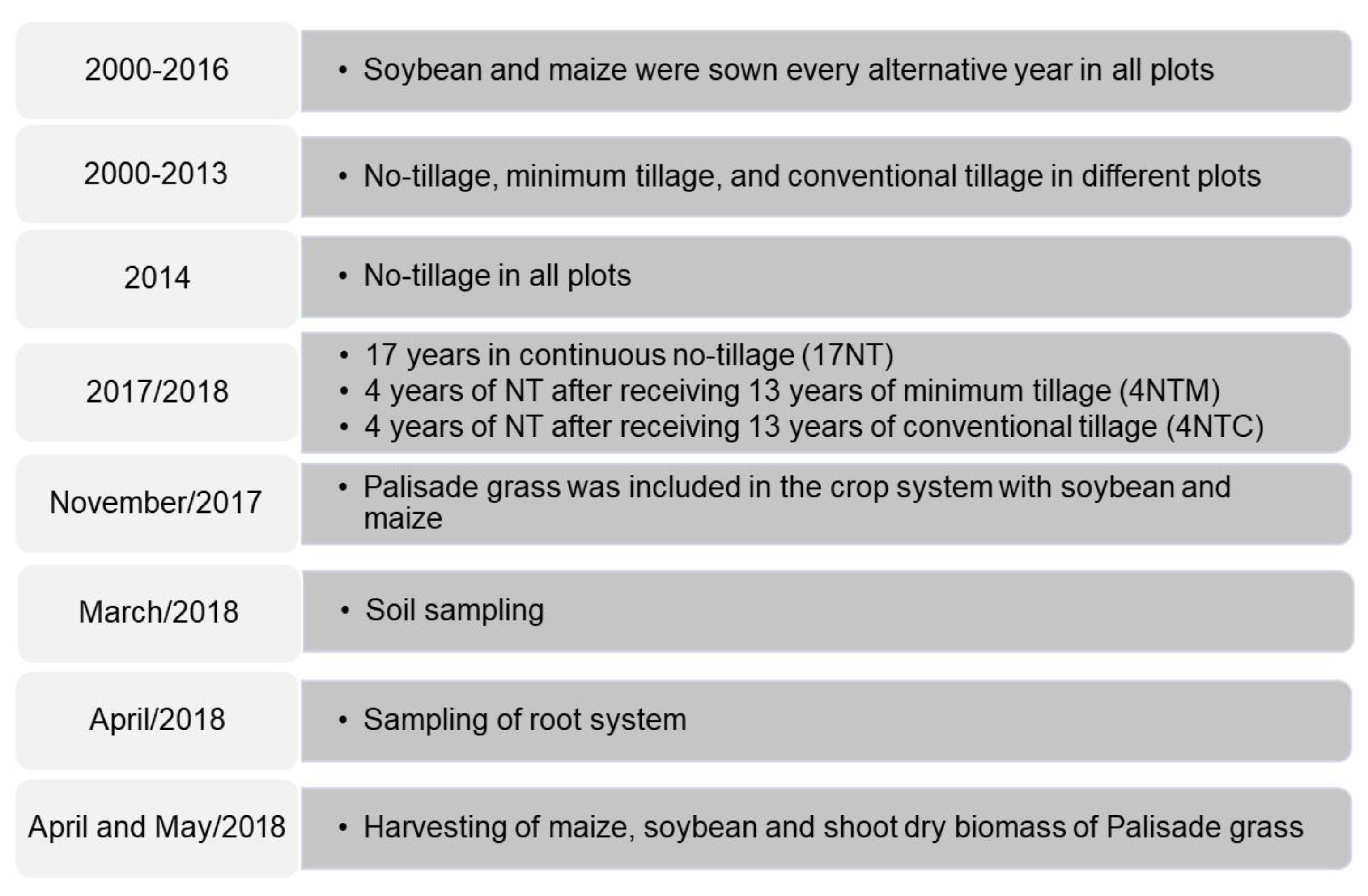
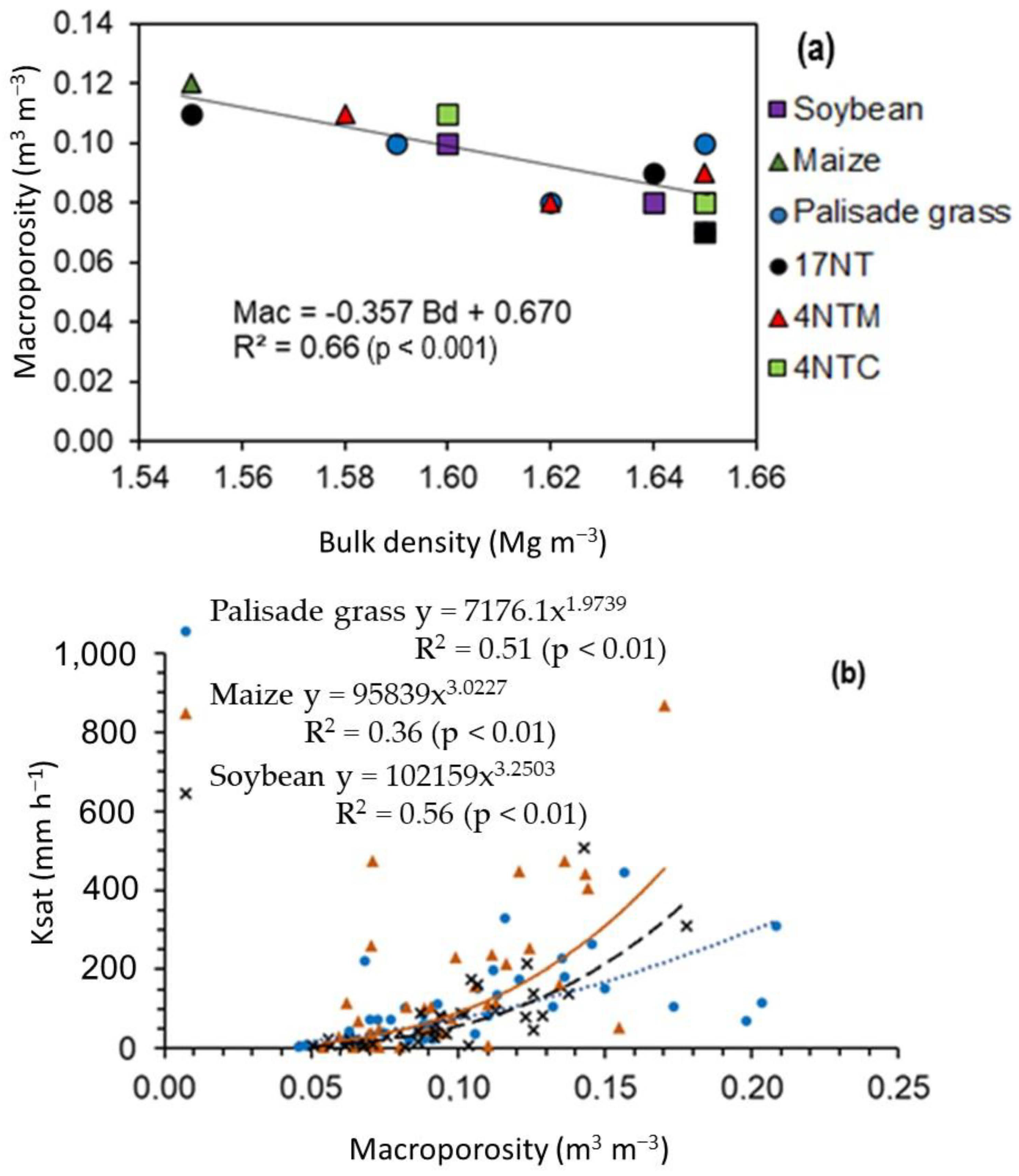
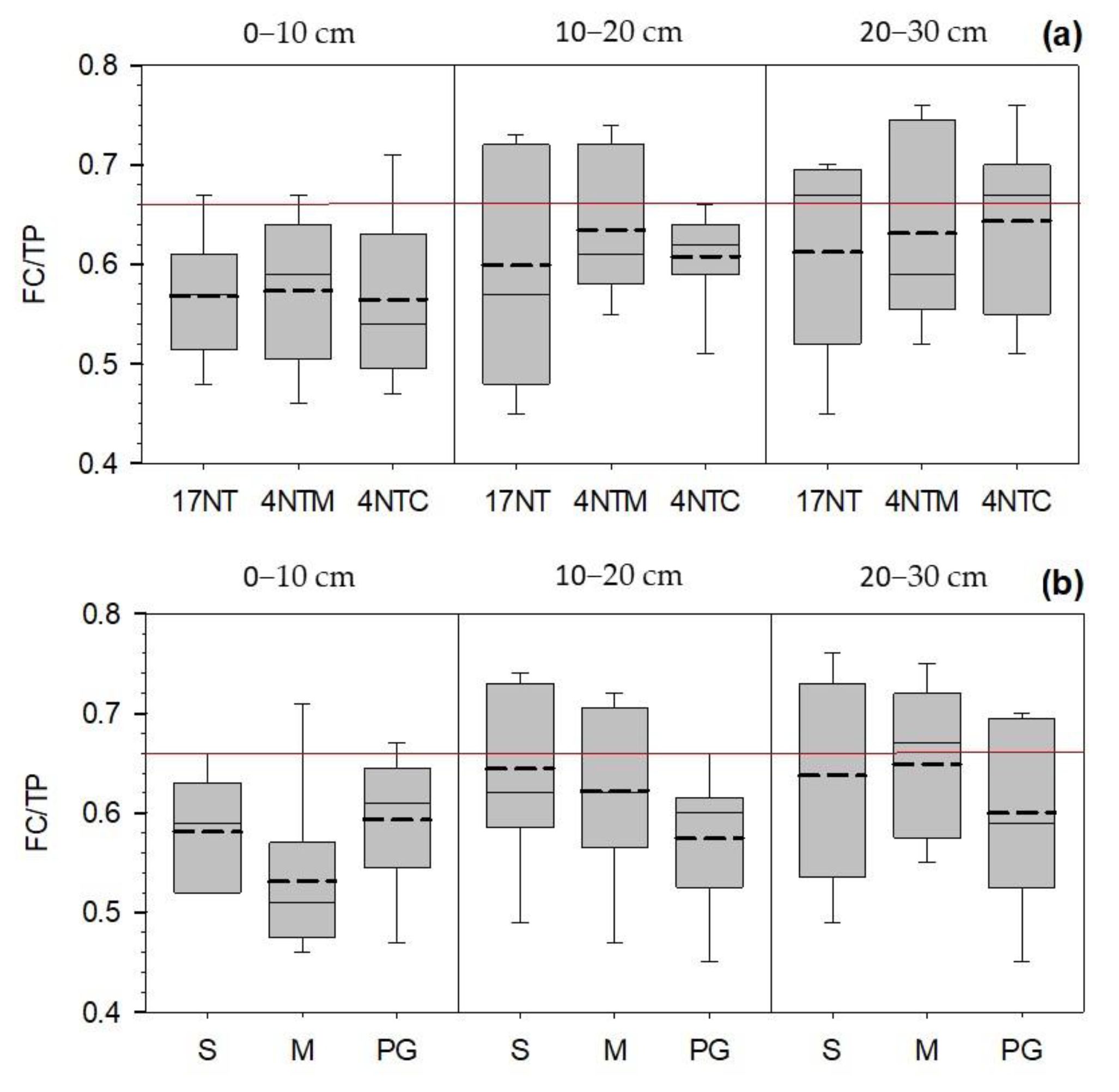
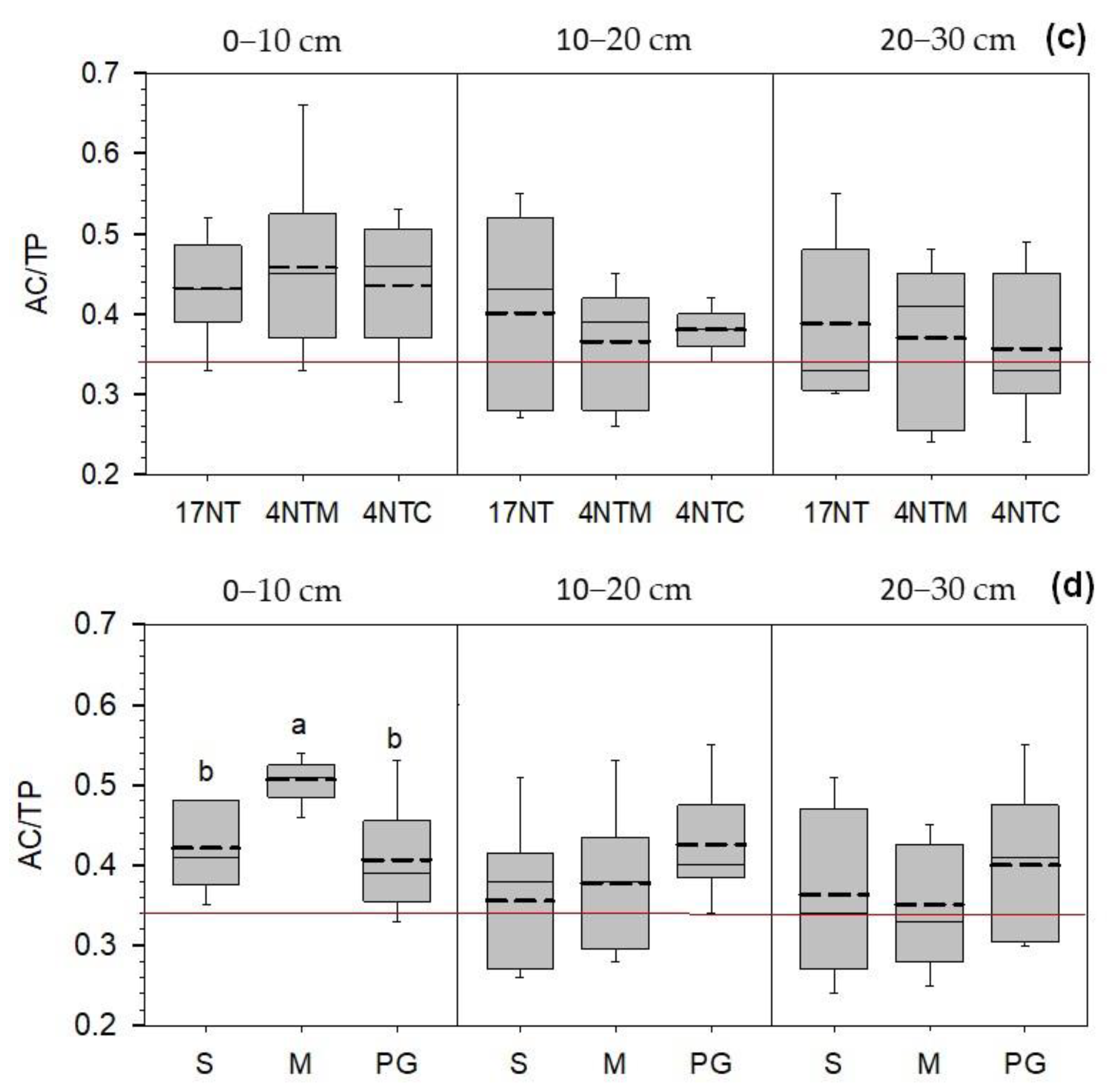
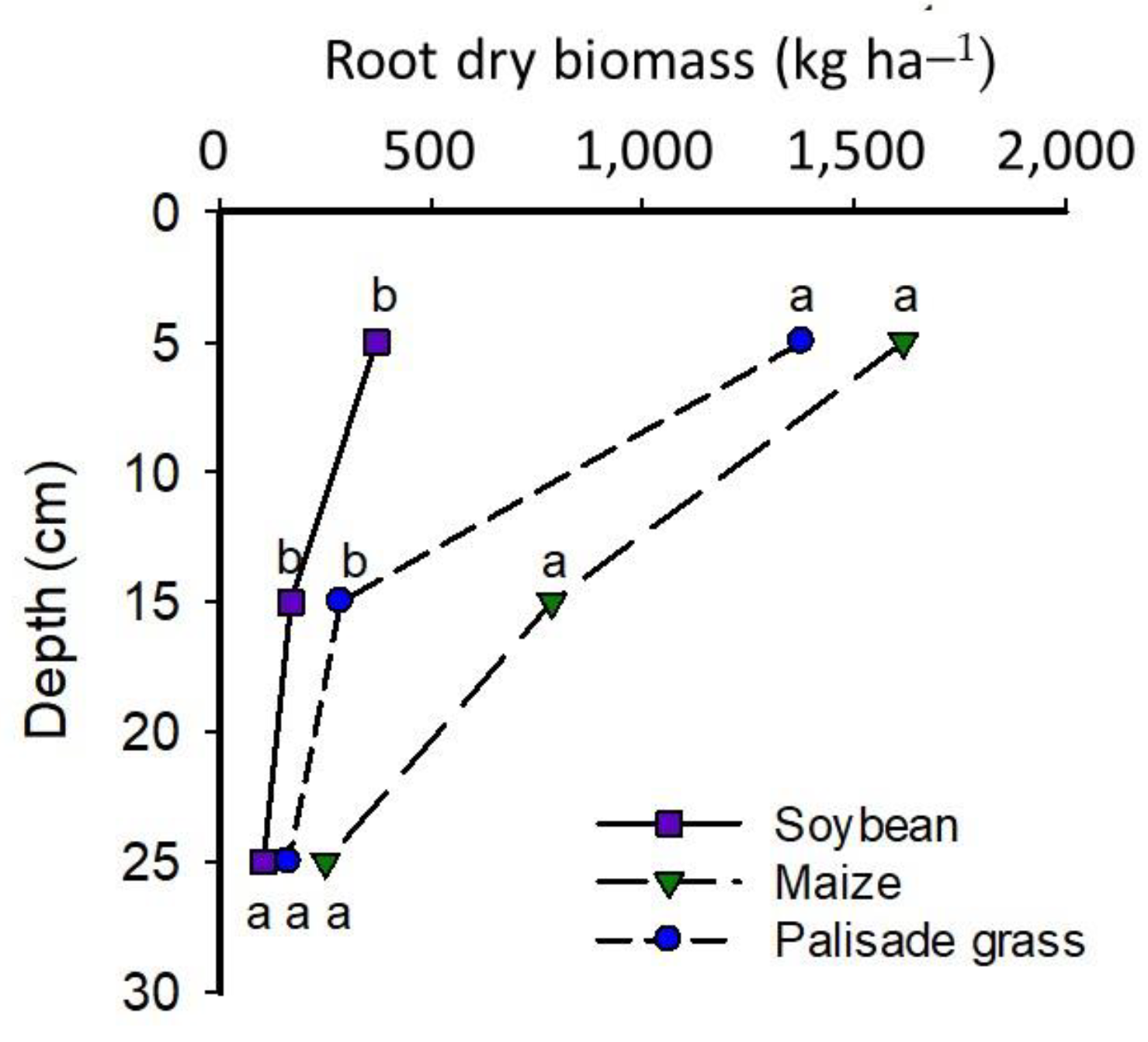
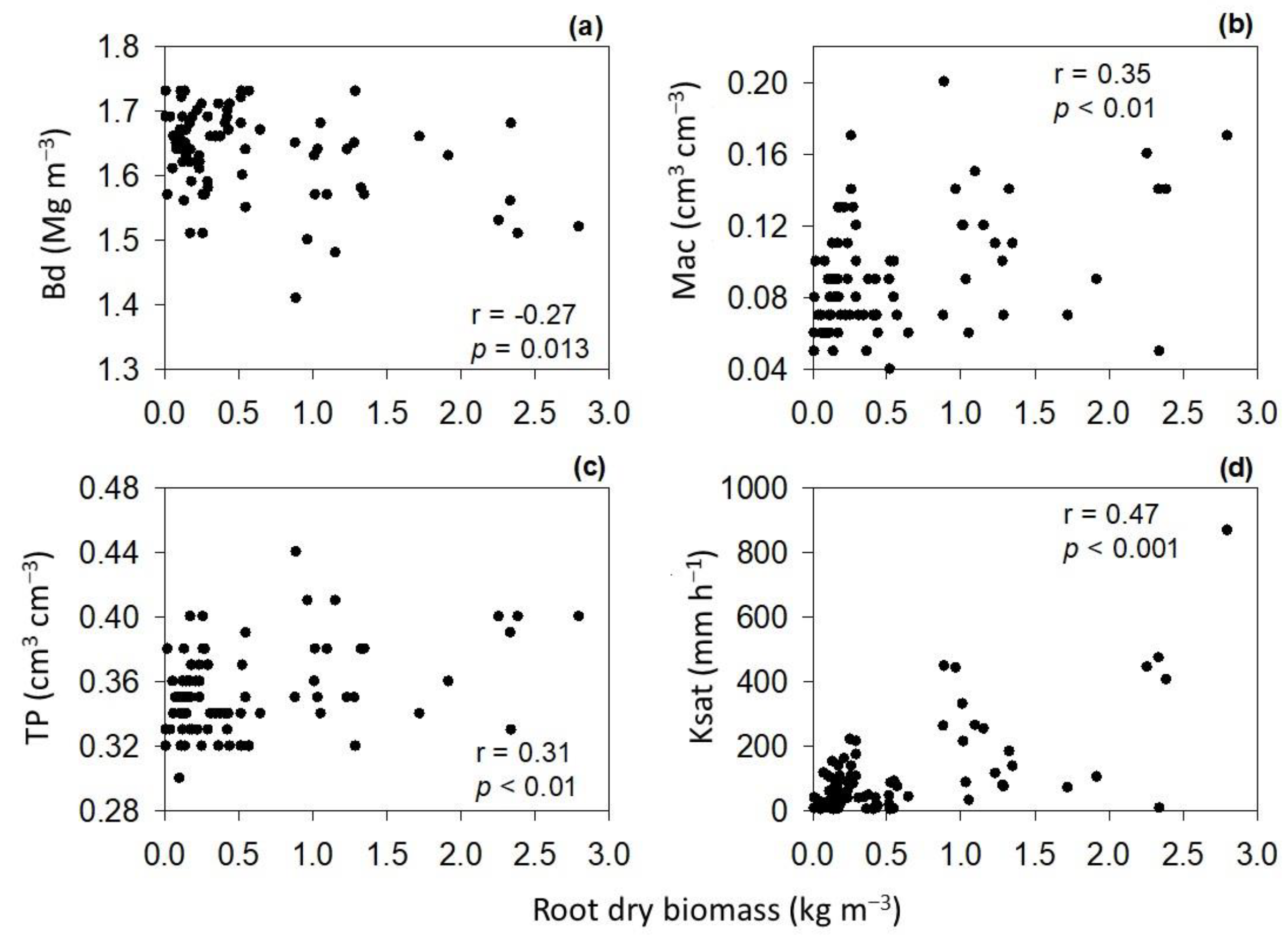
| Year | Winter | Summer | Year | Winter | Summer |
|---|---|---|---|---|---|
| 2000/01 | Native grass | Soybean | 2010/11 | Black oat + Vetch | Maize |
| 2001/02 | Black oat + Vetch | Maize | 2011/12 | Black oat + Vetch | Soybean |
| 2002/03 | Black oat + Vetch | Soybean | 2012/13 | Black oat + Vetch | Maize |
| 2003/04 | Black oat | Maize | 2013/14 | Black oat + Vetch | Soybean |
| 2004/05 | Black oat | Fallow | 2014/15 | Black oat + Vetch | Maize |
| 2005/06 | Black oat + Vetch | Soybean | 2015/16 | Black oat + Vetch | Maize |
| 2006/07 | Black oat + Vetch | Maize | 2016/17 | Black oat + Vetch | Soybean |
| 2007/08 | Black oat + Vetch | Soybean | 2017/18 | Black oat | Maize/Soybean/Palisade |
| 2008/09 | Black oat + Vetch | Maize | 2018/19 | Black oat | |
| 2009/10 | Ryegrass | Soybean |
| Treatment | Bd (Mg m−3) | Mac (m3 m−3) | Mic (m3 m−3) | TP (m3 m−3) | Ksat (mm h−1) | RBd (%) |
|---|---|---|---|---|---|---|
| Soil tillage | Layer 0–10 cm | |||||
| 17NT | 1.55 (0.07) ns | 0.11 (0.04) ns | 0.27 (0.02) ns | 0.38 (0.03) ns | 175 (53) ns | 96.88 |
| 4NTM | 1.58 (0.10) | 0.11 (0.04) | 0.25 (0.02) | 0.36 (0.03) | 204 (62) | 98.75 |
| 4NTC | 1.60 (0.05) | 0.11 (0.03) | 0.26 (0.01) | 0.37 (0.02) | 158 (44) | 100.00 |
| CV (%) | 5.6 | 31.7 | 5.4 | 7.5 | 35 | |
| Crops | ||||||
| Soybean | 1.60 (0.06) ns | 0.10 (0.02) ns | 0.26 (0.02) ns | 0.36 (0.03) ns | 118 (27) ns | 100.00 |
| Maize | 1.55 (0.07) | 0.12 (0.03) | 0.26 (0.02) | 0.38 (0.02) | 230 (48) | 96.88 |
| Palisade | 1.59 (0.09) | 0.10 (0.05) | 0.25 (0.02) | 0.36 (0.04) | 189 (27) | 99.38 |
| CV (%) | 4.8 | 24.5 | 2.9 | 6.4 | 76 | |
| Soil tillage | Layer 10–20 cm | |||||
| 17NT | 1.64 (0.06) ns | 0.09 (0.04) ns | 0.26 (0.02) ns | 0.35 (0.02) ns | 113 (55) ns | 102.50 |
| 4NTM | 1.65 (0.06) | 0.09 (0.02) | 0.26 (0.01) | 0.35 (0.02) | 122 (55) | 103.13 |
| 4NTC | 1.65 (0.06) | 0.08 (0.03) | 0.25 (0.02) | 0.34 (0.02) | 88 (28) | 103.13 |
| CV (%) | 3.4 | 20.8 | 4.2 | 4.8 | 90 | |
| Crops | ||||||
| Soybean | 1.64 (0.07) ns | 0.08 (0.03) ns | 0.26 (0.02) a | 0.35 (0.03) ns | 139 (45) ns | 102.50 |
| Maize | 1.65 (0.04) | 0.09 (0.03) | 0.26 (0.02) a | 0.34 (0.01) | 89 (19) | 103.13 |
| Palisade | 1.65 (0.06) | 0.10 (0.04) | 0.25 (0.02) b | 0.35 (0.02) | 95 (18) | 103.13 |
| CV (%) | 3.4 | 34.3 | 3.7 | 7.0 | 76 | |
| Soil tillage | Layer 20–30 cm | |||||
| 17NT | 1.65 (0.05) ns | 0.07 (0.02) ns | 0.28 (0.01) ns | 0.34(0.02) ns | 28 (11) ns | 103.13 |
| 4NTM | 1.62 (0.08) | 0.08 (0.04) | 0.26 (0.01) | 0.34 (0.04) | 55 (28) | 101.25 |
| 4NTC | 1.65 (0.05) | 0.08 (0.02) | 0.27 (0.02) | 0.34 (0.02) | 50 (10) | 103.13 |
| CV (%) | 6.1 | 13.8 | 5.6 | 5.2 | 71 | |
| Crops | ||||||
| Soybean | 1.65 (0.05) ns | 0.07 (0.02) ns | 0.27 (0.02) ns | 0.34 (0.02) ns | 37 (11) ns | 103.13 |
| Maize | 1.65 (0.05) | 0.07 (0.03) | 0.27 (0.01) | 0.34 (0.02) | 51 (15) | 103.13 |
| Palisade | 1.62 (0.08) | 0.08 (0.04) | 0.27 (0.02) | 0.35 (0.03) | 44 (14) | 101.25 |
| CV (%) | 6.7 | 27.4 | 6.0 | 6.2 | 99 | |
| Tillage | |||
|---|---|---|---|
| Crops | 17NT | 4NTM | 4NTC |
| Soybean | 2.65 (0.47) ns | 2.22 (0.50) | 2.48 (0.42) |
| Maize | 2.50 (0.76) ns | 2.69 (0.47) | 2.50 (0.42) |
| Palisade grass | 2.00 (0.45) B | 2.64 (0.47) A | 2.42 (0.57) AB |
| Crops | |||
| Tillage | Soybean | Maize | Palisade grass |
| 17NT | 2.65 (0.47) A | 2.50 (0.76) A | 2.00 (0.45) B |
| 4NTM | 2.22 (0.50) B | 2.69 (0.47) A | 2.64 (0.47) AB |
| 4NTC | 2.48 (0.42) ns | 2.50 (0.42) | 2.42 (0.57) |
Disclaimer/Publisher’s Note: The statements, opinions and data contained in all publications are solely those of the individual author(s) and contributor(s) and not of MDPI and/or the editor(s). MDPI and/or the editor(s) disclaim responsibility for any injury to people or property resulting from any ideas, methods, instructions or products referred to in the content. |
© 2023 by the authors. Licensee MDPI, Basel, Switzerland. This article is an open access article distributed under the terms and conditions of the Creative Commons Attribution (CC BY) license (https://creativecommons.org/licenses/by/4.0/).
Share and Cite
da Silva, T.S.; Suzuki, L.E.A.S.; Tormena, C.A.; Schmidt, M.R.; Mazurana, M.; Levien, R. Soil Tillage and Cropping System Effects on the Physical-Hydric Properties of a Soil under No-Tillage. Sustainability 2023, 15, 15936. https://doi.org/10.3390/su152215936
da Silva TS, Suzuki LEAS, Tormena CA, Schmidt MR, Mazurana M, Levien R. Soil Tillage and Cropping System Effects on the Physical-Hydric Properties of a Soil under No-Tillage. Sustainability. 2023; 15(22):15936. https://doi.org/10.3390/su152215936
Chicago/Turabian Styleda Silva, Tiago Stumpf, Luis Eduardo Akiyoshi Sanches Suzuki, Cássio Antonio Tormena, Marcelo Raul Schmidt, Michael Mazurana, and Renato Levien. 2023. "Soil Tillage and Cropping System Effects on the Physical-Hydric Properties of a Soil under No-Tillage" Sustainability 15, no. 22: 15936. https://doi.org/10.3390/su152215936
APA Styleda Silva, T. S., Suzuki, L. E. A. S., Tormena, C. A., Schmidt, M. R., Mazurana, M., & Levien, R. (2023). Soil Tillage and Cropping System Effects on the Physical-Hydric Properties of a Soil under No-Tillage. Sustainability, 15(22), 15936. https://doi.org/10.3390/su152215936







